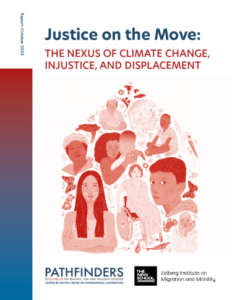Michigan State University College of Law Professor Justin Simard started the “Citing Slavery Project” in 2020 after researching sources for a project and stumbling upon citations of slave cases by modern judges.
Simard kept a record of these cases and a year later, he began working with students to compile more.
Since then, he has worked with around 25 students, who have contributed more than 2,500 hours of work, and now has about 15 law students working on the project.
“The goal of the project is to document all cases involving enslaved people, either as litigants or as the property and dispute, and (we cite) all the cases… on our website,” Simard said. “It is essentially to get scholars and lawyers to recognize the important influence that slavery has played on the development of American law.”
Simrad gives major credit to his team, who have scoured cases upon cases of legal precedent. He said they have “pushed the project in interesting directions.”
But how exactly does the group operate, and how do they find these citations?
The team uses commercial legal databases – the same ones lawyers typically use to perform usual legal research. Students are assigned to a set of cases and verify if each case involves slavery or not.
If they do, the team collects specific case information, such as related names, topics and states, and uploads the case to the “Citing Slavery Project” website, which is available to the public.
Simard said that the team is trying to “illustrate the specific influence of slavery in specific cases.”
The “Citing Slavery Project” has three main goals: finish collecting all 50 states’ cases, work with Cass Tech High School – a school located in Detroit – and make sure legal professionals address the fact that they may use slave cases in their arguments.
Anna Maxwell is a second-year student at MSU’s College of Law who joined the project within her first semester at school.
She said the project caught her eye when Simard explained the project to first-year law students, asking for anyone interested to perform data analysis and accumulate legal research.
“I just knew I wanted to be part of it in any capacity,” Maxwell said.
Maxwell’s main role involves legal research, which entails looking up cases in specific states. Currently, she is browsing through North Carolina. Although working on the project can be mentally taxing, Maxwell said, she always reminds herself of the project’s goals.
“It’s hard reading the cases, because it’s very dehumanizing material, but knowing that this is going towards the project is great,” Maxwell said. “The entire purpose… is to confront the fact that slavery is the foundation for a lot of American law, so being a new law student at the time, I was thinking ‘oh, why is this a project that seemingly no one’s heard of?’ And I was trying to figure out why the law didn’t already acknowledge its role in slavery.”
Another main component of the team is outreach: making sure the information provided is available to judges, lawyers, undergraduate students, graduate students and more recently, high school education programs.
Second-year law student Torence Witherspoon is mainly focused on the project’s outreach portion. After participating in an in-class discussion with Simrad, Witherspoon said, he became interested in the project and wanted to educate people on the lasting effects of slavery.
“As someone (who is) biracial and gay, I read a lot of judicial opinions over the last 150 years of our country’s history that are constantly limiting my rights or taking them away or not granting them,” Witherspoon said. “And I felt that there’s a lot of arguments around systemic racism or systemic oppression in our society.”
Witherspoon said the project has also been an instrumental “tool” in trying to educate people about racial oppression and spread awareness, something he had been trying to do beforehand.
“(The project) has worked better than anything else because it’s there,” he said. “It’s concrete. That’s why I’m so compelled to be in this research, and that’s specifically why I’ve worked on the outreach part of it.”
Support student media! Please consider donating to The State News and help fund the future of journalism.
As of right now, the “Citing Slavery Project” has collected roughly 14,000 slave cases and only has a few states left to cover.
In the past year, the team has been starting to collaborate with Cass Tech High School to educate students by breaking down cases and their historical contexts. Additionally, the project would give teachers the tools they need to update legal texts and curricula.
This would also help develop the school’s educational program and answer questions students have about law school, Simard said.
“We want to expand to other schools so that we can not only let high school students know about this, but also encourage students from a variety of backgrounds to become lawyers,” Simard said.
The project is also expected to entitle legal professionals to address slave cases if they cite them.
Witherspoon said lawyers have a professional and ethical responsibility to their clients and profession. Because of this, he said, knowing more about slave cases is necessary for legal professions.
“There’s a lack of intent behind understanding that these cases exist, and are being used and perpetuated through briefs, judicial opinions and people’s research without acknowledging or citing these cases,” Witherspoon said. “We as a legal profession owe it to both our clients and as advocates for both the law… to be aware that these slave cases exist and… to ensure that if we have to use them… then you’re citing them and you’re acknowledging them.”
If legal professionals use slave cases to cite precedent, Witherspoon said, they should acknowledge it. However, he added that in most instances, there are non-slave cases that can offer the same legal proposition.
Simard said he is interested in ethical standards and how the legal profession will continue to develop with his work.
“If we’re going to make a just legal system and take our duty as lawyers seriously, (it’s) important for us to think about how this law has shaped legal doctrines (and)… the system more generally,” Simard said. “It’s important for lawyers to… recognize this if we’re going to create that more just world that at least we all can say we support.”
Discussion
Share and discuss “MSU law professor creates project uncovering cases with legal citations of slavery” on social media.




